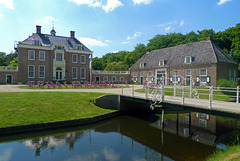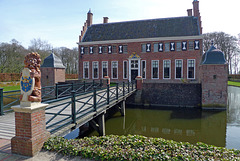Jaap van 't Veen's photos
Nederland -Diepenheim, Den Haller
| |
|
|
|
Watermill Den Haller is most probably the oldest still existing watermill in the Netherlands and the only remaining mill in the village of Diepenheim. It was first mentioned in the year of 1169. In 1331 Jan van Diest , bishop of Utrecht, bought the mill as part of the domain of Diepenheim . In the 18th century the mill was owned by the city of Deventer. The city council sold the mill in 1870 to Jan Hallers, who already had been the miller for many years, and became its present name “Den Haller”. It is now owned by a local foundation.
Watermill Den Haller is situated along the Diepenheimse Molenbeek in a protected rural area. It is a so called undershot mill and has three sets of millstones. The mill is open for visitors many days a week and is still used as a flour mill.
More info (Dutch):
www.molendatabase.nl/nederland/molen.php?nummer=787
www.watermolendenhaller.nl
Nederland - Kerk van Schildwolde
| |
|
|
|
Church of Schildwolde (Kerk van Schildwolde) dates from the 17th century. The present church was built on the foundations of an older church from the 13th century. The Reformed church is a simple aisle less church built of brick, which is plastered. The church was consecrated in 1686.
The most striking part of the complex is the detached bell tower, dating back at least to the year 1289 and once belonging to the former church. The roof of the spire is not made of roof tiles, but entirely built in brick. The tower has a height of 46 metres.
The tower in Schildwolde is one of the two remaining so called ‘juffertorens’ (‘damsel towers’) in the province of Groningen. There is a legend about the ‘juffertorens’, saying: once there were three very rich but 'sinful' sisters (the ‘damsels') who thought only of their appearance. They regretted their sins and promised they would each build a tower as penance for their sins.
But most probably the name ‘juffertoren’ is less prosaic: this kind of narrow tapering church towers were called after a ‘juffer’, which in Dutch also is a long tapering pine trunk.
Spain - Andalusia, La Peza
| |
|
|
|
La Peza is a small Andalusian village located on the slope of Monte Rosado and in front of the Sierra Nevada
La Peza was an old Roman castro, whose name comes from the word lápice (stone).
In the times of the Roman domination it receives the name of Roman Castrum and this time is the one that dates the origin of this town.
Spain - Catalonia, Siurana
| |
|
|
|
Siurana is a more or less hidden tiny village, situated on top of a massive fourty metres high limestone escarpment at an altitude of 737 m. The village offesr extraordinary views to the artificial lake Pantà de Siurana and the surrounding mountains of Monsant and Prades, and a nearby canyon with its red, orange, yellow and grey coloured rocks.
Siurana is old village, built by the Moors and was the last bastion in Catalonia conquered by the Christians in 1153. Its narrow alleyways wind around a handful of medieval houses, a charming church and the ruins of a castle.
Nowadays Siurana has less than 40 inhabitants. The only access to the village is by car through a steep winding road from Cornudella de Montsant. It is often visited by tourists for its history and spectacular vies and by rock climbers due to the abundance of sport climbs.
Spain - Catalonia, Prades Mountains
| |
|
|
|
Prades Mountains (Muntanyes de Prades), is a mountain massif north of Reus. It is forested with oak and pine trees. Poblet Monastery, located at the feet of the range.
Prades Mopuntains is well known for rock climbing on the steep rocks. Centre for this activity is the tiny village of Siurana.
Picture: taken from Siurana with a view into the canyon with the winding road towards the village.
Nederland - Friesland, Huize Oranjewoud
| |
|
|
|
In 1664 the Frisian Nassau’s bought some heathland east of Heerenveen known as ‘t Wold’. The ‘village’ became its name 'Oranjewoud' ('Orange Forest' – Orange is the colour of the Dutch royal family) in the year of 1676, when Albertina Agnes, Prinses van Oranje Nassau, after the death of her husband Willem Frederik van Nassau - Stadtholder of Frisia - bought an existing country estate.
Early 18th century her daughter-in-law Henriëtte Amalia van Anhalt-Dessau modernized the manor by (landscape) architect Marot (well known for the construction of Palace Het Loo nearby Apeldoorn). Marot designed two new wings for Oranjewoud, but the central building was never built. The architect also planned the gardens and park around the manor. During the French occupation, both wings were demolished and the property was sold. Two estates were built where the Stadtholder's country house had once stood: Oranjewoud at the site of the old castle and Oranjestein where the home of the steward had been.
Various generations of the Oranje-Nassau family spent their summer at Oranjewoud.
White plastered Huize Oranjewoud - built 1834 on the place of the former (royal) Palace Oranjewoud - is surrounded by a beautiful garden and a moat. It is private owned and it can not be visited. Opposite of the house is the entrance to the so called ‘Overtuin’ - see note - a lovely garden/park in English style.
Nederland - Woudrichem, "Nooit Gedagt"
| |
|
|
|
Flour mill "Nooit Gedagt" is standing on one of the bastions of the fortress of Woudrichem.
Originally the mill was built in the year of 1682 and was destroyed during World War II. "Nooit Gedagt" was rebuilt and reopened in 1996.
Woudrichem itself is one of the official eleven Dutch fortress towns and its name ‘Walrichsheim' was already found in the year of 866. It became known as Woudrichem as from 1290, and could already be considered a town at that time, having a sheriff, aldermen and a council. It became city rights in 1356.
For another view of the same windmill: www.ipernity.com/doc/327263/28234661/in/group/100944
Nederland - Katlijk, Thomaskerk
| |
|
|
|
Katlijk (Ketlik in the Frisian language) is a tiny village nearby Heerenveen. It has a little charming old church called Thomaskerk (Thomastsjerke), which is dating back to 1525. The church is built of ‘rooswinkel’ bricks and has some heavy buttresses. The building stands on an artificial dwelling hill and is surrounded by a graveyard with some real old tombstones.
It has no tower, but next to the church stands a so called ‘klokkenstoel’: a wooden bell tower, which is typical for the province of Friesland.
The Thomaskerk is a wonderful example of simple beauty in a peaceful rural location.
Spain - Andalusia, Embalse de Canales
| |
|
|
|
Embalse de Canales ( Canales Reservoir) is a artificial lake of the Genil River. The reservoir is located in the foothills of the Sierra Nevada, east of Granada and nearby the mountain village of Güéjar Sierra (see: note).
The massive dam at the western end of the lake has a height of almost 160 metres and is 340 metres long.
Spain - Catalonia, Monastery of Poblet
| |
|
|
|
The Cistercian Monastery of Poblet (Monestir de Poblet) was founded in 1150.
In the courtyard of the cloister is a Romanesque lavabo situated. The fountain was used by the monks in their daily ablution ritual.
Nederland - 't Harde, Zwaluwenburg
| |
|
|
|
Part of the estate grounds of Kasteel Zwaluwenburg ( www.ipernity.com/doc/294067/27937469/in/album/537955 ) is so called 'Klein Zwitserland' (Little Switzerland). It is a little bit hilly area with winding narrow paths. In spring it is full with flowering rhododendrons and azaleas of different colours.
Nederland - 't Harde, Zwaluwenburg
| |
|
|
|
Kasteel Zwaluwenburg was first mentioned in 1326 as 'KasteelWijnbergen' and was for long time inhabited by the family Wijnbergen. The present building is dating back to 1728 and is considered being one of the most beautiful stately homes in the province of Gelderland.
Zwaluwenburg is surrounded by beautiful estate grounds with woodland, fields and meadows and a couple of out buildings and farm houses.
One of the most beautiful parts - especially in spring - is so called Klein Zwitserland (Little Switzerland - a rather hilly part with numerous flowering rhododendrons and azaleas: www.ipernity.com/doc/294067/27937491/in/album/537905
Nederland - Oploo, 'D'n Olliemeulen'
| |
|
|
|
'D'n Olliemeulen' - watermill along the stream the 'Vloet' in Oploo, province of Noord-Brabant. The mill is dating back to the year of 1725; nowadays this former oil mill is used as a flour mill.
Locals call the mill also 'Het watermolenken op het Peelbeexken'.
Very nearby you also will find a post mill called 'De Korenbloem'.
Nederland - Uithuizen, Menkemaborg
| |
|
|
|
The Menkemaborg* in Uithuizen is a 14th-century, brick-built country house, which was substantially altered around 1700; since then it has since barely been changed. Nowadays, being part of a museum, the borg is open for public.
*In the Dutch province of Groningen a 'borg' is a former stronghold or estate house, surrounded by moats and gardens.
Nederland - Uithuizermeeden, Mariakerk
| |
|
|
|
The oldest part of the Dutch Reformed Church of Uithuizermeeden is dating back to the 13th century.
The white walls were plastered in the 19th century.
The church tower (Meister Toren) was renewed in 1717, commissioned by Onno Tamminga of Alberda, lord at the nearby Rensumaborg. After a fire at the end of the 19th century the tower was rebuilt in its original form. The remarkable white and blue tower has a height of 48,5 metres.
The church has a beautiful interior and a Hinz organ, which was consecrated in 1785.
Spain - Granada, Cathedral
| |
|
|
|
Building of the Granada Cathedral (Cathedral of the Incarnation) was started in 1523. It took 181 years for the cathedral to be built completely.
This cathedral is considered to be a masterpiece of Spanish Renaissance.
Picture: looking towards the unprecedented rounded main altar and the impressive dome with a height of 45 metres. The two organs can also be seen.
Spain - Catalonia, Monastery of Poblet
| |
|
|
|
The Monastery of Poblet (Monestir de Poblet) was founded in 1150. It is a Cistercian monastery and still used by a monastic community.
Nederland - Veenwouden, Schierstins
| |
|
|
|
The 'Schierstins' in Veenwouden is a medieval 'Stienhús' (stone house) built around the year of 1300 out of brick and is the only remaining 'Stienhús' in Friesland.
The 'Schierstins' was first mentioned in 1439 on a piece of parchment.
Jump to top
- ipernity © 2007-2024
- Help & Contact
|
Club news
|
About ipernity
|
History |
ipernity Club & Prices |
Guide of good conduct
Donate | Group guidelines | Privacy policy | Terms of use | Statutes | In memoria -
Facebook
Twitter


















